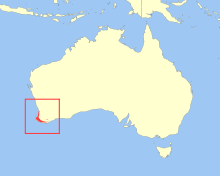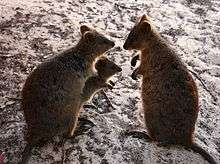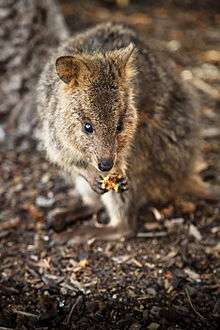Quokka
| Quokka | |
|---|---|
 | |
| Scientific classification | |
| Kingdom: | Animalia |
| Phylum: | Chordata |
| Class: | Mammalia |
| Infraclass: | Marsupialia |
| Order: | Diprotodontia |
| Family: | Macropodidae |
| Subfamily: | Macropodinae |
| Genus: | Setonix Lesson, 1842 |
| Species: | S. brachyurus |
| Binomial name | |
| Setonix brachyurus (Quoy & Gaimard, 1830) | |
 | |
| Geographic range | |
The quokka (/ˈkwɒkə/, Setonix brachyurus), the only member of the genus Setonix, is a small macropod about the size of a domestic cat.[2] Like other marsupials in the macropod family (such as kangaroos and wallabies), the quokka is herbivorous and mainly nocturnal.
Quokkas can be found on some smaller islands off the coast of Western Australia, in particular on Rottnest Island just off Perth and Bald Island near Albany. A small mainland colony exists in the protected area of Two Peoples Bay Nature Reserve, where they co-exist with the critically endangered Gilbert's potoroo.
Description
The quokka weighs 2.5 to 5 kilograms (5.5 to 11.0 lb) and is 40 to 54 centimetres (16 to 21 in) long with a 25-to-30-centimetre-long (9.8 to 11.8 in) tail, which is fairly short for a macropod. It has a stocky build, rounded ears, and a short, broad head. Although looking rather like a very small kangaroo, it can climb small trees and shrubs. Its coarse fur is a grizzled brown colour, fading to buff underneath.
After a month of gestation, females give birth to a baby called a joey. Females can give birth twice a year. The joey lives in its mother’s pouch for six months. Once it leaves the pouch, the joey relies on its mother for milk for two more months. At 1.5 years old, quokkas are old enough to have their own babies.[3]
Discovery by Europeans


The quokka was one of the first Australian mammals seen by Europeans. The Dutch mariner Samuel Volckertzoon wrote of sighting "a wild cat" on Rottnest Island in 1658. In 1696, Willem de Vlamingh mistook them for giant rats and named the island "Rotte nest", which comes from the Dutch word rattennest meaning "rat nest".[4]
The word quokka is derived from a Nyungar word, which was probably gwaga.[5]
Ecology
In the wild, its roaming is restricted to a very small range in the South-West of Western Australia, with a number of small scattered populations. There is one large population on Rottnest Island and a smaller population on Bald Island near Albany.[6] The islands are free of foxes and cats. On Rottnest, quokkas are common and occupy a variety of habitats ranging from semi-arid scrub to cultivated gardens.[7]
Diet
Like most macropods, quokkas eat many types of vegetation, including grasses and leaves. A study found that flowering plants of the genus Guichenotia are one of the quokka's favourite foods.[8] Rottnest Island visitors are urged to never feed quokkas, in part because eating "human food" can be very detrimental to the quokka's health, causing them to be dehydrated and malnourished.[9] Despite the relative lack of fresh water on Rottnest Island, quokkas do have high water requirements, which they satisfy mostly through eating vegetation. On the mainland quokkas only live in the areas that have 600 ml or more of rain per year.[10]
Population
Although numerous on the small offshore islands, the quokka has a very restricted range and is classified as vulnerable.[6] On the mainland, where it is threatened by most introduced predatory species such as foxes, it requires dense ground cover for refuge. Clearfell logging and agricultural development have reduced this habitat, thus contributing to the decline of the species. The introduction of cats and dogs, as well as dingoes, has added to the problem, as has the clearing and burning of the remaining swamplands. Moreover, quokkas usually have a litter size of one and successfully rear one young each year. Although these animals are constantly mating, usually one day after their young is born, the small litter size paired with the restricted space and threatening predators contribute to the scarcity of these marsupials on the mainland.[11]
The quokka population on Rottnest Island is 8,000–12,000 (2008). Snakes are largely the quokka's only predator on the island. The population on the smaller Bald Island, where the quokka has no predators, is 600–1000. There are an estimated 4,000 quokkas on the mainland, with nearly all mainland populations in groups of less than 50, although there is one declining group of over 700 in the Southern Jarrah-Karri Forest.[12] In 2015 the massive Northcliffe bushfire decimated one of the local mainland populations, with an estimated 90% or 500 quokkas dying.[13] At the end of summer and into autumn, the quokka population on Rottnest Island dies off due to lack of water, a limiting factor there.[10]
"Quokka selfie" viral sensation
The quokka has little fear of humans and it is common for quokkas to approach people closely, particularly on Rottnest Island. It is, however, illegal for members of the public to handle the animals in any way, and feeding, particularly of "human food", is especially discouraged as they can easily get sick. An infringement notice carrying a A$300 fine can be issued by the Rottnest Island Authority for such an offense.[14] The maximum penalty for animal cruelty is a $50,000 fine and five years in jail.[15][16][17]
It has, however, especially since a 2013 Huffington Post feature article,[18] become increasingly popular to take "selfies" with the animal where it seemingly smiles,[19] which, combined with its relative lack of predators on the island, has caused many to label it "the happiest animal in the world". The hashtag "quokkaselfie" is commonly used to share them at social media sites such as Twitter[20] and Instagram.[21]
References
- ↑ de Tores, P.; Burbidge, A.; Morris, K. & Friend, T. (2008). "Setonix brachyurus". IUCN Red List of Threatened Species. Version 2008. International Union for Conservation of Nature. Retrieved 29 December 2008.
- ↑ Groves, C.P. (2005). Wilson, D.E.; Reeder, D.M., eds. Mammal Species of the World: A Taxonomic and Geographic Reference (3rd ed.). Baltimore: Johns Hopkins University Press. p. 69. OCLC 62265494. ISBN 0-801-88221-4.
- ↑ "Quokka Facts | Quokkas | Australian Marsupials". Animalfactguide.com. Retrieved 2016-08-25.
- ↑ "Quokka". Australian Museum. Retrieved 2016-08-25.
- ↑ Dixon, R. M. W.; Moore, Bruce; Ramson, W. S.; Thomas, Mandy (2006). Australian Aboriginal Words in English: Their Origin and Meaning (2nd ed.). Oxford: Oxford University Press. ISBN 0-19-554073-5.
- 1 2 Roger Underwood, Doomed Planet: On the origin of the specious, Quadrant, August 31, 2012
- ↑ "A close encounter of the furry kind". Australian Geographic. 2010. Retrieved 2010-04-22.
- ↑ "Quokkas' favourite foods and shelter identified in Rottnest Island study". ABC News.
- ↑ "Quokkas and Wildlife". Rottnest Island. Retrieved 2016-08-25.
- 1 2 http://www.abc.net.au/news/2016-10-17/quokkas-rottnest-island-smile-but-island-life-no-paradise/7930208
- ↑ Nocon, Wojtek. "Sentonix Brachyurus". Quokka. University of Michigan. Retrieved 30 September 2013.
- ↑ "Setonix brachyurus — Quokka Glossary". Environment.gov.au. Retrieved 2016-08-25.
- ↑ http://www.abc.net.au/news/2016-09-06/northcliffe-quokka-population-decimated-after-2015-bushfire/7818884
- ↑ Rottnest Island Regulations 1988 (WA), rr 40 & 73; sched. 4
- ↑ "Quokka cruelty: French tourists fined after pleading guilty to burning animal on Rottnest Island - ABC News (Australian Broadcasting Corporation)". Abc.net.au. 2015-04-17. Retrieved 2016-08-25.
- ↑ Rottnest Island Regulations 2007 (WA), r 40
- ↑ Squires, Nick (12 January 2003). "Rare marsupials kicked to death in 'quokka soccer'". The Daily Telegraph (London).
- ↑ Grenoble, Ryan (7 January 2013). "Meet The Quokka, The Happiest Animal In The World". Huffington Post. Retrieved 20 February 2016.
- ↑ Carty, Sarah (26 February 2015). "Why haven't YOU taken a selfie with a quokka yet? Tourists posing with adorable Australian furry animals sparks hilarious '#quokkaselfie' trend". dailymail.co.uk. Retrieved 20 February 2016.
- ↑ "#quokkaselfie hashtag on Twitter". Twitter.com. Retrieved 2016-08-25.
- ↑ "#quokkaselfie • Instagram photos and videos". Instagram.com. Retrieved 2016-08-25.
Bibliography
- Ronald M. Nowak (1999), Walker’s Mammals of the World (6 ed.), Baltimore: Johns Hopkins University Press, ISBN 0-8018-5789-9, LCCN 98023686
External links
| Wikimedia Commons has media related to Quokka. |
| Wikispecies has information related to: Setonix brachyurus |
| Look up quokka in Wiktionary, the free dictionary. |
